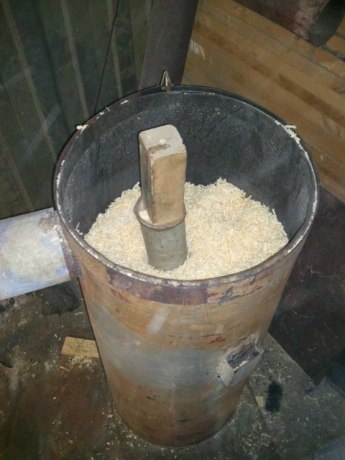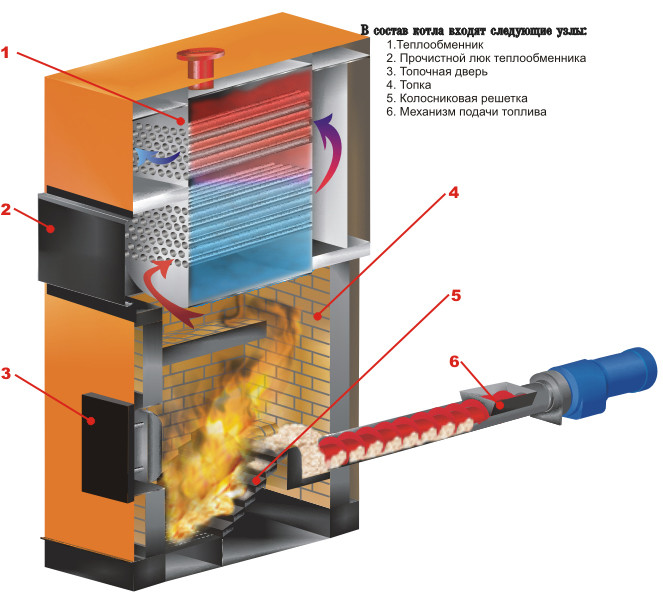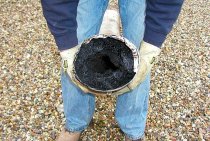Know
- If the sawdust boiler is to be used for heating the house, it should be slightly modified to ensure indoor safety. For this purpose, holes are made in the skin of the water jacket and fittings for temperature and pressure control devices are attached. The best option would be to install a relief safety valve, which would be put into action when the temperature reaches 3 bar. The pipe from the valve will need to be brought outside.
- Another problem is the hot surface of the boiler and chimney. Since heat is distributed in the furnace, where it is completely unnecessary. Therefore, sawdust-fired boilers must be insulated. You can create a thermal insulation effect with your own hands using basalt wool, which is highly resistant to high temperatures. Wool can be sheathed with a layer of polymer-coated sheet metal, at the same time giving the boiler an aesthetic appearance.
How to load fuel
The process of putting fuel into sawdust boilers is not at all complicated. To begin with, a cone-shaped pipe is inserted into the hole in the lid. This form is very convenient, because it is easy to get it at the right time. Sawdust falls asleep until it reaches the level of the chimney. Each portion of fuel must be rammed. Then the pipe is carefully removed. Through the hole, oxygen will enter the device, and the smoke will go outside. Next, you need to cover the oven with a lid and set fire to the sawdust from the outer end of the vertical pipe. The melting process can be accelerated by pouring a little flammable liquid onto the metal baffle up to the biomass loading level. In a boiler with a volume of about 200 liters, sawdust burns from 8 hours, and the furnace must not be opened until complete combustion. Thus, a new portion of fuel can be filled up only after the end of this process.

Should I use a reflector in the boiler?
When making a sawdust boiler with their own hands, many do not know whether it is necessary to insert a reflector into it. Experts advise doing this, especially if the boiler will be used in small rooms. They explain this by the fact that during the operation of the device, the temperature of its case is extremely high. In the case of a sawdust boiler, the heating output is even higher than in other devices. The reflector will allow you to correctly redistribute heat flows and ensure uniform heating of the entire room. That is why it also helps to save money on heating - the use of a reflector reduces fuel costs by a third!
A sawdust boiler does not always need to be lined with bricks. The decision will depend on the situation: if it costs in a garage, greenhouse or utility room, such work will only be a waste of time and money. But the device for the living quarters should be finished and placed in a brick firebox. This will have its drawbacks - it will become much more difficult to use the device and maintain it.
Before assembling the device with your own hands, you need to familiarize yourself with some of the features of their operation:
- Chimney parts are assembled in the direction opposite to the movement of smoke and combustion products.
- The design of the chimney should be convenient for disassembly and regular cleaning.
- Since the boiler body becomes very hot, care must be taken that there are no flammable objects near it. The walls next to which the appliance will be located must be finished with heat-resistant materials.
- After completing the assembly of the device with your own hands, it must be tested in different modes of operation. Testing will allow you to find the optimal temperature regime and determine the required amount of fuel for one cycle of operation.
Arrangement of the furnace
It is better to install any device for heating in a greenhouse in the winter approximately in the middle of the room. It is necessary to equip the base for the installation of a heating system made of bricks or ceramic or paving slabs.
Set of tools
When arranging a long-burning furnace for heating a greenhouse, it is necessary to prepare the following tools:
- markers for drawing sizes;
- grinder for cutting metal;
- welding machine;
- protective mask and gloves.
Calculation of the required material
For the manufacture of the heating system, you must first prepare the following materials:
- a metal barrel of 200 liters;
- metal pipe;
- metal corner;
- steel sheets;
- gas cylinder (second-hand).
Did you know? This furnace was designed by the Russian scientist I. N. Butakov. He is the founder of the theory of combined production of electrical and thermal energy.
Carrying out the installation of the oven
Installation of the furnace is carried out in the following sequence:
- Cut off the top of the cylinder, and make a hole at the bottom for solid fuel to enter.
- From the side of the cylinder, cut an opening for mounting the chimney.
- A circle of metal should be turned so that it fits into the barrel. A hole is made in it for a blower, and the circle itself for weighting and a gap near the fuel is trimmed with metal fittings (corner).
- A piece of pipe with a damper is attached to the lid by welding, which will act as a blower.
- A chimney, a door made of a piece of steel or part of a barrel is fixed by welding. Install the legs.
The operation of such a device for heating is to burn firewood with limited air access. Under the pressure of gravity, the cover moves down, showing the level of fuel burnout.
Self-production in stages
Owners of a country house or, for example, a garage can make a stove on sawdust with their own hands, however, before installation work, you should equip the foundation - this will ensure the fire safety of the unit. After installing the equipment, it must be overlaid with refractory bricks or a water circuit should be installed. For installation work, the following materials will be required:
- a barrel with walls at least 10 mm thick (desired barrel volume is about 200 l);
- two metal pipes;
- refractory bricks and cement.
From the tools you will need a channel, a welding machine, a grinder (plus cutting wheels), a hammer, a hacksaw.
Fuel tank preparation
The upper part of the barrel, from which the fuel tank is made, is cut off with a grinder. You can, of course, use a hacksaw for metal, but the trimming process will be delayed. The upper part of the barrel should be cut only after correct marking, otherwise the workpiece will be damaged.
During work, you need to make sure that the grinder disk does not overheat, and also cut off exactly along the marked line. The rest is not necessary to throw out - it is suitable as a lid for the stove.
Installation of pressure pad and supply pipe
When preparing the pressing circle, it should be taken into account that its diameter should be somewhat smaller than the diameter of the fuel tank (barrel with a cut-out top). A hole is cut in the central part of the circle, the diameter of which must correspond to the diameter of the supply pipe. The channel must be cut with a hacksaw into 4 parts and welded directly to the pressure circle - this will make the structure more durable.
Then, the supply pipe and the circle are combined with each other by a welding machine. The pipe must be equipped with a damper for better regulation of the air entering the furnace - an easy-to-manufacture damper is a metal circle equipped with a steel handle.
Installation piping and cover
To remove the smoke from the unit, an exhaust pipe must be connected to the furnace. To do this, a special hole is cut out in the upper part of the fuel tank and the pipe itself is attached by welding.Its connection to the main heating system is carried out using a clamp. As a lid, it is best to use the previously cut out upper part of the barrel with welded handles. The furnace must be reliably protected from overheating, for which a reflector is welded to the outside of the tank. It is made from metal.
This design will give a long burning, and this will solve the problem of providing housing with heat. Moreover, in the independent manufacture of such a furnace, fairly inexpensive materials are used.
Principle of operation

The design of the furnace of such a boiler does not provide for the presence of a door and an ash pan: the fuel is laid on top so that it occupies the space from the bottom to the opening of the chimney pipe. Over the entire plane, the fuel presses down a round-shaped load made of thick steel, to which a vertical pipe is attached to supply air to the device. A special hole in the lid of the boiler allows the pipe to pass through it to the outside. The device is ignited through the outer end of the pipe. Thus, the fuel begins to burn from the upper layers, gradually heating the water jacket.
A damper is made at the outer end of the pipe, which allows you to adjust the air supply and the rate of burning of the biomass. As the fuel burns, the load inside the boiler lowers, gradually reaching the bottom. Combustion products can be removed from the furnace through the chimney.


